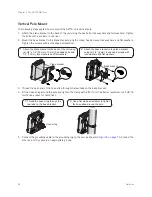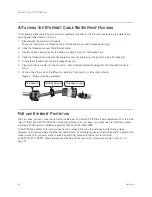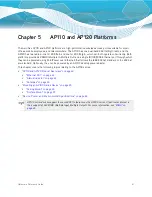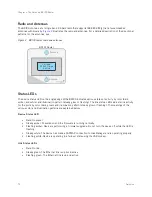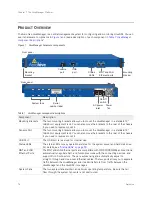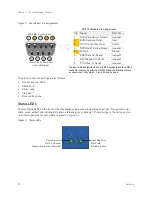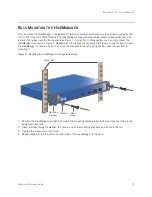
Chapter 5 AP110 and AP120 Platforms
64
Aerohive
Status Indicator
The status indicator has been incorporated into the Aerohive logo on the top of the AP110 and AP120. It is
illuminated by various colors to indicate different states of activity. The meanings of the colors are as follows:
•
Dark: There is no power or the status indicator is disabled.
•
Blue: (solid) The device is booting up or there is no backhaul link; (flashing) the device is shutting down.
•
Green: The default route is through the backhaul Ethernet interface, but not all conditions for normal
operations (white) have been met.
•
Yellow: The default route is through a backhaul wifi interface, but not all conditions for normal operations
(white) have been met.
•
White: The device is powered on and the firmware is operating normally; that is, a wireless interface in
access mode is up, a wired or wireless backhaul link is up, and the HiveAP has a CAPWAP connection to
either HiveManager or a management AP.
•
Purple: A new image is being loaded from HiveManager or a management AP.
•
Orange: An alarm indicating a firmware or hardware issue has occurred.
For locations where the status indicator might be a distraction or attract unwanted attention, you can adjust its
brightness level from bright (the default) to soft to dim. You can even turn it off completely. In HiveManager,
choose the brightness level that you want from the LED Brightness drop-down list on the Configuration >
Advanced Configuration > Management Services > Management Options page. Through the CLI, enter
[ no ]
system led brightness { soft | dim | off }
. The four settings are represented graphically in
.
Figure 2 Adjustable status indicator brightness levels
Antennas
Antennas are an integral part of both the AP110 and AP120. The AP110 has two internal dual-band antennas.
The AP120 has four internal single-band antennas. Two of the antennas operate in the 2.4-GHz band (IEEE
802.11b/g/n) and have a 0-dBi gain. The other two antennas operate in the 5-GHz band (IEEE 802.11a/n) and
have a 3-dBi gain. All antennas are omnidirectional, providing fairly equal coverage in all directions in a cardioid
(heart-shaped) pattern around each antenna (see
On the AP110, the two dual-band antennas link to a dual-band radio, which can operate in the 2.4-GHz band for
802.11b/g/n or the 5-GHz band for 802.11a/n, but not in both bands simultaneously. On the AP120, the two
2.4-GHz antennas link to one radio, and the two 5-GHz antennas link to the other radio, both of which can
operate concurrently. Conceptually, the relationship of antennas and radios is shown in
Figure 3 Antennas and radios
\
Bright
Soft
Dim
Off
5 GHz
antenna
5 GHz
antenna
2.4 GHz
antenna
2.4 GHz
antenna
2.4GHz / 5 GHz
dual-band
antennas
AP110
AP120
Radio
RF 802.11a/b/g/n
2.4 GHz / 5 GHz
Radio 2
RF 802.11a/n
5 GHz
Radio 1
RF 802.11b/g/n
2.4 GHz
(Cut-away views of the AP110 and AP120 showing the relationship of the internal antennas and radios)
Summary of Contents for Aerohive APs
Page 1: ...Aerohive Hardware Reference Guide ...
Page 7: ...Contents 6 Aerohive ...
Page 17: ...Chapter 1 The AP330 and AP350 Platforms 16 Aerohive ...
Page 47: ...Chapter 3 The AP320 Platform 46 Aerohive ...
Page 61: ...Chapter 4 The AP170 Platform 60 Aerohive ...
Page 91: ...Chapter 8 The High Capacity HiveManager 90 Aerohive ...



